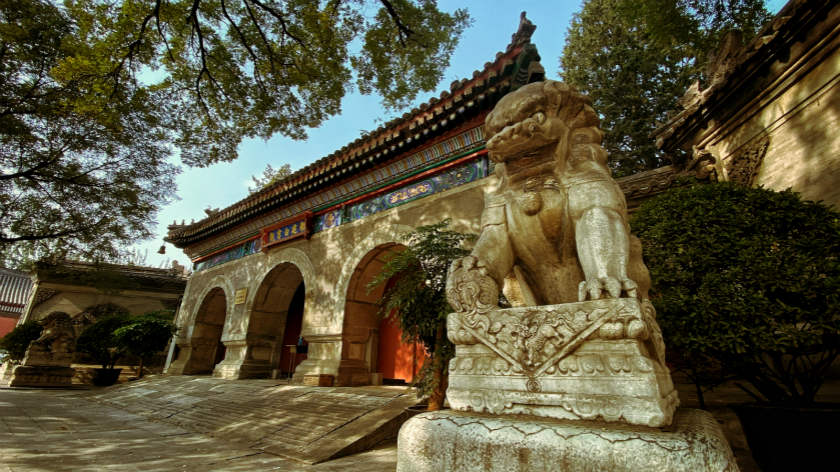Chinese Name: 白云观 Pronunciation: Báiyún Guàn
Ticket Fare: 10 yuan
Building Time: 739
Best Visiting Season: All seasons
Recommended Time for Visit: 1-3 Hours
Address: No. 9, Baiyunguan Street, Xicheng District, Beijing
Occupied Area: About 6 hectares (60,000 square meters)
Building Area: About 1 hectare (10,000 square meters)
Popular Activities: Taoist ceremonies and Spring Festival fairs will be held.
Building Function: A royal Taoist temple and the ancestral court of the Quanzhen Sect of Taoism.
Service Hours
| Contents | Summer Time (May 1-September 30) | Winter Time (October 1-April 30) |
| Temple Gate Opening Hours | 8:30-17:00 | 8:30-16:30 |
| Ticket Office Opening Hours | 8:30-16:30 | 8:30-16:00 |
The White Cloud Temple is an active, vast, and fascinating temple of halls, shrines, and brightly painted immortals, tended by Quanzhen Sect priests with their hair gathered into topknots. Many local people come to the temple during the Spring Festival to enjoy the temple fair.
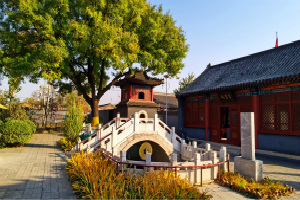
The White Could Temple was built in the Tang Dynasty (618-907), called Tianchang Temple, where the Emperor Xuanzong (his reign 712-756) worshiped Laozi (the founder of Taoism and philosopher in the Spring and Autumn Period). During the Tang Dynasty, the emperors advocated Taoism, so they had built lots of Taoist temples throughout the country. The White Could Temple is the oldest one in Beijing with a thousand years of history.
The outlook and of the halls and pavilions that you may see had formed in the Qing Dynasty (1644-1912). The temple is divided into four main parts: the middle section, the east and west sections, and the backyard. All of its main halls and buildings are on the central axis, including the main gate, the Lingguan Hall, the Yuhuang Hall, the Laolü Hall, the Qiuzu Hall, the Sanqing Hall, and their subordinated halls, covered corridors, and side rooms are placed on both sides of the central axis.
Walking from the middle section, the Screen Wall will come into your view. Then, you may see the Outer Gate Tower, the Cloud Pillar, the Main Gate, the Wofeng Bridge (Wofeng means stopping the wind), the Lingguan Hall, Drum and Bell Towers, the Sanguan Hall, the Caishen Hall (Caishen means god of fortune), the Yuhuang Hall (the Jade Emperor Hall), the Jiuku Hall, the Yaowang Hall, the Laolü Hall (Laolü means commandments), the Qiuzu Hall, and the Siyu Sanqing Hall.
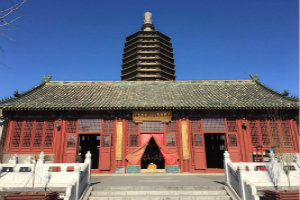
In the west of the White Cloud Temple, there are the Celestial Beast (statue of the divine animal Te), the Sitang Hall, the Baxian Hall, the Luzu Hall, the Yuanjun Hall, and other halls. The Celestial Beast, made of bronze, looks like a horse but with a mule body, donkey face, horse ears, and cattle hoofs. The left and right walls of the Sitang Hall are inlaid with stone inscriptions about Tao Te Ching by Zhao Mengfu (a calligrapher in the Yuan Dynasty).
In the east of the White Cloud Temple, there are the Sanxing Hall, the Cihang Hall, the Zhenwu Hall, and the Leizu Hall. The backyard of the White Cloud Temple is called Rear Garden. The Ordination Stage and the Yunji House are located in the center of it. The Ordination Stage is an altar for the Quanhen Sect to teach religious discipline. The Yunji House is for Taoists to expound their scriptures.
The White Cloud Temple, the chief temple of the three ancestral temples of the Quanzhen Sect of Taoism, currently houses the Chinese Taoist Association, the Institute of Chinese Taoist Culture, and the Chinese Taoist College.
The White Cloud Temple was established in 739, named Tianchang Temple.
In 1192, the White Cloud Temple was repaired and was called Taiji Palace.
Master Qiu Chuji, known as Changchun Taoist of Quanzhen Sect, was appointed by Emperor Genghis Khan (1162-1227) to be in charge of Taoism throughout the country in Taiji Palace. And then the Taiji Palace was renamed Changchun Palace.
In 1227, after Master Qiu Chuji died, his student Yin Zhiping built a Taoist Temple on the east of the Changchun Palace, called the White Cloud Temple.
In the late Yuan Dynasty, the Changchun Palace was destroyed during the battles, but the White Cloud Temple was preserved.
The White Cloud Tempe was repaired and expanded during the Ming and Qing Dynasties.
In 1957, the White Cloud Temple was the site of the China Taoist Association.
In 1979, the White Cloud Temple was the cultural relics protection unit in Beijing.
On June 25, 2001, the White Cloud Temple, as an ancient building of the Qing Dynasty (1644-1912), was approved by the State Council to be included in the fifth batch of important heritage site under state protection.
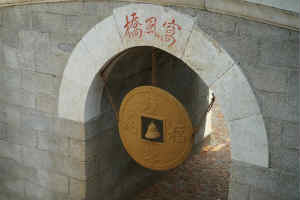
The Wofeng Bridge was built in 1706. After it was destroyed, the Wofeng Bridge was reconstructed in 1988. It is a single-span stone bridge facing south and north.
There is no water under the bridge. On each side of the bridge, an ancient copper coin hangs on, and a small copper bell is inside the coin eye.
The copper coin is engraved with four Chinese characters “钟响兆福” which means when the bell rings, the blessing will arrive. So, there is a popular activity--hitting the golden coin’s eye. You can buy some small copper coins to try your luck.
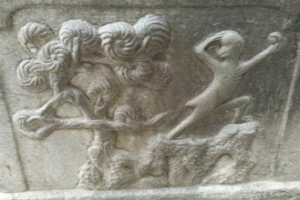
The Mountain Gate, the main gate of the temple, is made of stone with three portals. The three archways are a symbol of three realms (the heaven, the underworld, and the human). If you enter the Mountain Gate, you may walk into where the celestial beings lived. The walls of the Mountain Gate are engraved with clouds, cranes, and flowers.
There is a stone monkey, palm-sized, which hides in the relief on the east of the middle door. A legend spreading in old Beijing is that the celestial beings are no trace to be found, but they left stone monkeys in the White Cloud Temple. So, the stone monkeys are the embodiment of the celestial beings. Every visitor will touch that stone monkey for good luck.
There are three tone monkeys hiding in the White Cloud Temple. You may look for them carefully. So, there is a saying--three stone monkeys do luckily to be met with.
There is a story about the name of Wofeng Bridge. Qiu Chuji, an influential Taoist, built the White Cloud Temple on imperial orders as the predominant Taoist temple in the north of China.
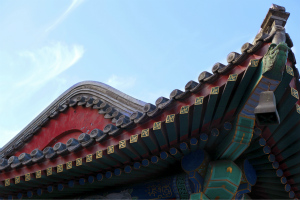
A monk planned to build a Buddhist temple attracting more people than the White Could Temple and named it the West Wind Temple. That means the west wind would blow out the cloud and the West Wind Temple will overcome the White Cloud Temple.
The Taoist priest of the White Cloud Temple knew the plan, and at that time, the last stone bridge would be finished. He named the bridge Wofeng Bridge (literal meaning, stopping the wind). No matter how strong the west wind was, the wind would not get through the bridge.
Enter from the Mountain Gate → Wofeng Bridge → Lingguan Hall → Sanguan Hall → Caishen Hall → Yuhuang Hall → Yaowang Hall → Laolü Hall → Qiuzu Hall → Siyu Sanqing Hall → the backyard of the White Cloud Temple
Take bus 26, 45, 80, 320, Double-decker 19, or Night 14, and get off at the Baiyunguan Station.
Take Metro Line 1, get off at the Muxidi Station, and walk about 1.3 kilometers.
Take Metro Line 7, get off at the Daguanying Station, and walk about 1.7 kilometers.
Chinese: 请带我去白云观。English: Please take me to the White Cloud Temple.
If you go to the White Cloud Temple from the center of Beijing (Grand Hyatt Beijing), it takes about 25 minutes (about 35 yuan).
If you go to the White Cloud Temple from Beijing Capital International Airport, it takes about 55 minutes (about 120 yuan).
If you go to the White Cloud Temple from Beijing Daxing International Airport, it takes about 1 hour and 5 minutes (about 180 yuan).
If you go to the White Cloud Temple from Beijing West Train Station, it takes about 10 minutes (about 15 yuan).
